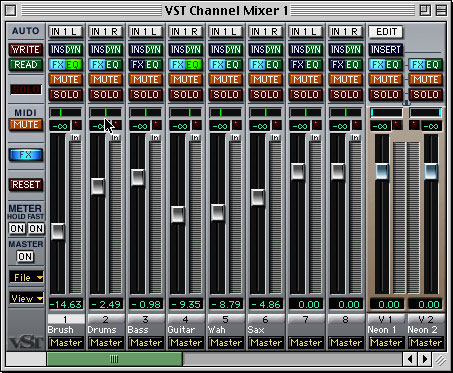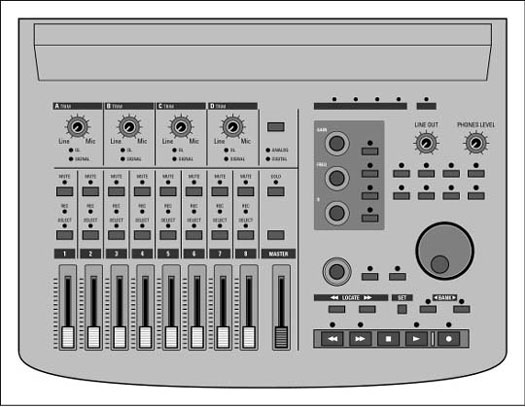>
Figure 1: The analog mixer has tons of knobs, lights, and faders to play with.
Digital mixer
The digital mixer, as shown in Figure 2, is a great option for home studio owners because it can perform the same functions as a conventional analog mixer in a lot less space. Routing — the process of sending your signals to various places within the mixer — becomes almost easy using one of these. You can switch between input and track channels without having to change a single cord.
Digital mixers handle all the busing and routing tasks within the digital domain. With no cords to mess with, you have a lot less possibility for noise to enter the system. And if noise does enter the system, it's easier to find and eliminate.
One of the great things about digital mixers is the ability to automate your mix. You can set-up complex fader and effects changes to run automatically. Some digital mixers even have motorized faders, which are really fun to watch!
>

>
Figure 2: The digital mixer performs the same functions but takes up less space than an analog mixer.
Software mixer
If you want the flexibility of a digital mixer and don't have an overpowering need to physically touch the faders and knobs, then a software mixer (shown in Figure 3) may work for you. The software mixer is included with any computer audio or MIDI production software. The advantage with a software mixer is that after you have the computer and audio software that you want, you have nothing else to buy.
Software mixers work much the same way as a digital mixer. Because they are digital, you have an almost infinite variety of routing choices that you can make without having to patch and re-patch cables. Still, some people may not be too keen on having to use a keyboard and a mouse to get mixing work done rather than working with the more traditional knobs or slide faders.
For those of you who want the best of both worlds — high-tech computer software and tactile stimulation — you can find control surfaces that allow you to control the software's mixer using real faders and knobs, as you can read in the next section.
>

>
Figure 3: Use your mouse and computer keyboard to control a software mixer.
The computer control surface
If you end up with a computer-based system with a software mixer, you'll have some knobs, buttons, and faders to play around with on the computer control surface, as shown in Figure 4. Aside from being able to fiddle with some knobs, you'll find that a computer control surface is a handy tool if you decide to use a computer-based Digital Audio Workstation (DAW) and want (or need) to control the virtual mixer with some hardware.
>

>
Figure 4: A computer control surface acts like a digital mixer for a computer-based system.
These controllers send MIDI messages — messages coded using the Musical Instrument Digital Interface communications protocol — to the computer that tells it which parameters to change. These controllers can easily be programmed to work like a separate digital mixer.
Not all software works with a computer control surface, so make sure that you check with the software or computer control surface manufacturer before you buy it.
>
dummies
Source:http://www.dummies.com/how-to/content/meeting-the-many-mixers-for-home-recording.html
No comments:
Post a Comment